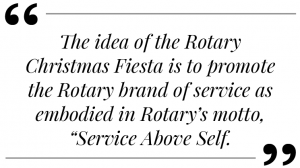 I welcomed the Christmas season in the most special way by helping organize a fiesta for children with special needs last Saturday, December 2, at the Bagani Hall in Camp Merecido, Catitipan, Davao City.
I welcomed the Christmas season in the most special way by helping organize a fiesta for children with special needs last Saturday, December 2, at the Bagani Hall in Camp Merecido, Catitipan, Davao City.
First, let me share some back story. Last year, when Davao City was slowly opening up from the Covid-19 pandemic-related lockdowns, I proposed to our Rotary Club of Downtown Davao (RCDD) that we hold a Rotary Christmas Fiesta and former PNP Chief Archie Gamboa, our President then, gave his all out support to make it happen. It was so successful that we decided to make it an annual event.
The idea of the Rotary Christmas Fiesta is to promote the Rotary brand of service as embodied in Rotary’s motto, “Service Above Self.” And what better time to showcase the generosity, fun, goodwill, friendship and fellowship of Rotarians than Christmastime, right? It is also a good way for our Rotary club and our partners-in-service to come together to celebrate the season in a meaningful way by choosing to create a fiesta for beneficiaries who belong to the most vulnerable and underserved communities.
Last year, the chosen beneficiaries were the orphaned children from ChildHope Field of Dreams Foundation and our private sector partners were SM City Davao and SM Cares.
This year, upon the recommendation of our honorary member, Davao City Schools Division Superintendent Rey Solitario, our beneficiaries are 100 children with special needs coming from various public elementary schools in the city. Our generous private sector partner this year is Vitarich Corporation, producers of Cook’s chicken.
And what a very special Rotary Christmas Fiesta it was!
Inspired by this year’s Rotary theme, “Create Hope in the World,” our fiesta for children with special needs revolved around the message that “Hope is the Heart of Christmas.”
We started the fiesta with a Christmas Parade with all participating children wearing Christmas-inspired costumes. Later on, they showcased their talents through the Hope in Motion dance showdown; Sing for Hope Christmas solo caroling; and The Colors of Hope art showcase.
We were all captivated by the joy seen on the children’s faces for having a safe space where they can creatively express themselves without fear of being ridiculed or laughed at. Quite the opposite because we were all genuinely amazed.
Children with hearing impairment danced so gracefully and in sync with the beat of the music and with each other without hearing any sound. They memorized all the dance steps their teacher taught them and would just “feel” the vibration of the sound surrounding them and that includes the clapping and swaying they see from the audience who were watching them and cheering them on.
Children with intellectual disability showcased their awesome dancing (they executed splits!) and singing abilities that those considered intellectual geniuses would probably have difficulty mastering. Goes to show that being a so-called intellectual is so overrated.
We also witnessed how children with autism spectrum disorder as well as those diagnosed with emotional-behavioral disorder had so much fun because they were able to freely express themselves. Even their teachers and parents were so happy to see their children just being children.
As UNICEF said: “Like all children, children with disabilities have ambitions and dreams for their future. And like all children, they need quality education to develop their skills and realize their full potential.”
UNICEF estimates that there are about 1.6 million Filipino children with disabilities. Based on the Department of Education (DepEd) data for school year 2016-2017, there are almost 233,000 learners with disabilities or learning exceptionalities mainstreamed in regular classes.
In Davao City, there are around 5,000 learners with special needs mainstreamed in regular classes. These learners are diagnosed by specialists to have visual impairment, hearing impairment, learning disability, intellectual disability, autism spectrum disorder, emotional-behavioral disorder, orthopedic/physical handicap, speech/language disorder, cerebral palsy, special health problem/chronic illness, and multiple disabilities.
Part of promoting inclusivity in education, children with special needs are now enrolled in regular classes with learners who are evolving typically. We can imagine how challenging that must be for teachers. Teaching at any level is already hard. Teaching children with special needs takes more attention, more energy, more time, and more resources. Managing an inclusive classroom means teachers are expected to do more with less.
I saw the dedication and patience of the teachers and parents who accompanied the 100 children with special needs to our Rotary Christmas Fiesta last Saturday and I am in awe of each and every one of them.
I asked one teacher, who was running around trying to keep up with her hyperactive pupil, how she copes with the challenges. I expected her to sigh and confide in me how difficult it is, but instead she was beaming as she looked at her pupil. She said with a big smile: “I personally brought my most hyperactive pupil here today and dressed him up in a Santa Claus outfit because I know he would love being around lots of people and being the center of attention. He requires three minders just to keep up with him on a daily basis!”
A parent also approached me, in tears of joy, hugged me and said: “Thank you for doing this for our children. I kept praying for years that some group would organize something like this even just for Christmas so that our children will feel the love from others in the community, not just from their own family.”
And I got more smiles and hugs from the children themselves just expressing their love and pure joy. They were unrestrained in their show of affection and unfiltered in their self-expression. They were very clear in communicating to us that what we did is a very good thing and they like it a lot.
Before we ended the fun-filled morning, we distributed Bags of Hope to all the children. Each bag contained art supplies, hygiene kits, and nutritious food like milk and yogurt. Most children I have encountered would always go first for the food treats. But these children are really special because most of them got excited by the art supplies and immediately used them.
I think that is a clear indication that we need to focus on nurturing children’s creativity and allowing them to freely express themselves. Education must be fun so we will develop in children a lifelong love for learning. That is something we cannot “standardize” or grade. Like kindness, empathy, faith, hope, and love — values we need to nurture to produce good citizens of the world.
DepEd must treat all children as special because we are all uniquely created. Each learner has special needs — whether diagnosed with a disability or not — so we should not design an educational program like an industrial factory for mass production.
It is my Christmas wish that DepEd, our top performing government agency according to the latest poll, will start a Creativity Revolution in education. And because it takes a village to raise a child, we all must help to make it happen. ###




